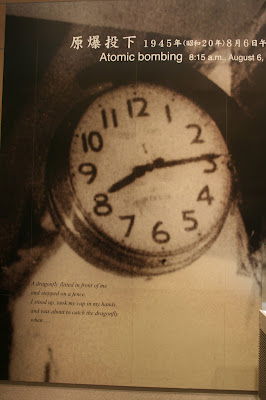We left the boys with our friends, the Hootens, when we took the train and trolley to Peace Park (about an hour travel time, one way.) Eventually, we will take the kids, but Rodney and I wanted to be able to read the informational signs and absorb the history without anyone whining about being thirsty, bored, hot, hungry, cold or having sore feet.
The museum is usually closed on New Years Day, but opened this year as an "experiment," according to the web site. It was pretty busy, so I wouldn't be surprised if it stayed open in future years. The museum itself is very interesting, enlightening and depressing, all at once. Of course, being the spouse of a United States Marine, as well as an educated, yet empathetic person, I have conflicting feelings about all of it. Everything from "I'm so sorry!" and "Please don't hate me," to "You bombed us first!" and "The war needed to end" ran through my head. Of course, there was a part of me that wanted to keep my back to the wall and my hands free in case the melted tricycle or shredded children's clothing on display incensed the crowd. After all, the Americans were severely outnumbered at the museum. But, as far as I know, I didn't see any dirty looks thrown my way, so they were thrown when my back was turned or not at all. Perhaps the two 6-foot, 3-inch-plus men in our group were a deterrent, or perhaps the majority of the people there are of a similar mindset to mine: This sucked, let's not do it again, and how can we prevent it? And, essentially, that is what the museum focuses on, albeit in a Sally Struthers sort of way.
For those who were asleep during history class, the Enola Gay dropped the "Little Boy" atomic bomb on Hiroshima at 8:15 a.m. Aug. 6, 1945. Clocks and watches in the area that were not destroyed all stopped on the time.
Photographs of the actual mushroom cloud were taken from vantage points from all across the prefecture
One of the first things visitors see in the museum are these 3D maps of the "before" and "after." The bridge closest to the center of the photographs is the one we cross to get from the trolley stop to Peace Park. The lone building left standing there by the bridge was a kimono shop before World War II, then because government offices during the war. It is now the visitor's center for Peace Park.
Survivors gathered in stunned groups for days, looking for food, water, shelter and medical care. The Japanese government forbid photography and many photographs and drawings were destroyed to keep the level of devastation under wraps.
Dozens of artifacts have been donated to the museum by the government and families of survivors. A large number of these items on display are from school children. The marketer in me knows that this is to pull at the heartstrings of visitors and get them to sign the anti-nuke petitions as they exit (by the way, American military members are not allowed to sign these). In reality, many children had been sent out of the city to the country to keep them safe from the air raids, while the adults remained behind to work. Of course, not all children were evacuated, and many did perish in the bombing or from effects afterward, but the percentage of artifacts from and stories told about children, rather than adults, in the museum was very high.
 |
| Junior high school student's uniform |
 |
| Grade school student's uniform |
 |
| Tricycle |
 |
| During the blast, this woman was wearing a kimono that had a dark pattern in it, leaving the pattern burnt in to her skin. |
 |
| Many of us have heard of the "shadows" left behind after the blast. This photo shows a shadow of a valve wheel on an iron wall. |
 |
| This man had his hand outside a window during the blast. His fingernails grew in black and deformed afterward. The museum had one of the nails on display in the box to the left. |
 |
| Burns were graded by appearance. Some photographs of the worst suffered by survivors were on display. |
Today, Hiroshima is known as the "Museum of Moving Trams." It is one of the few cities that still has trams, which were popular Japanese modes of public transportation at the time of World War II. On this 3D map below, where the bomb's fireball is depicted in orange, you can see a number of bridges running across the many rivers in the city. Within three days of the blast, the tram company got the city's trams running again, except to the bridge closest to ground zero, because the bridge was destroyed. The people of Hiroshima found the sight of these trams encouraging during the recovery effort and still hold them in high esteem.
Part of the museum explains how many nuclear bombs there are in the world, and where they are located:
 |
| I hope American military intelligence has a better guess than a question mark for North Korea. |
As mentioned earlier, we headed to the Chicken Shack for supper. It was already crowded at 5 p.m., so we ended up sitting outside in the 43-degree weather with intermittent sprinkles, at tables with heat underneath. These kept our legs warm, but I still wore gloves, and all of the adults in the group had a hard time sitting cross-legged through the entire meal. The food was incredibly tasty, though! While were were there, samurais with a New Year dragon roamed through the tables. When the dragon came up to you, you lowered your head and it "bit" you to give you happiness through the year. All of us were "bitten," and this is Will getting bit.























No comments:
Post a Comment